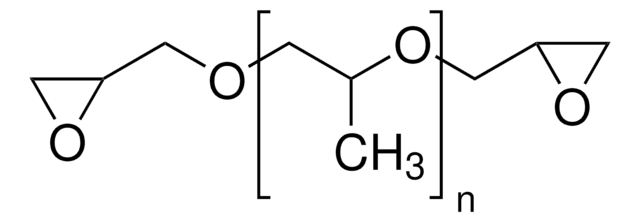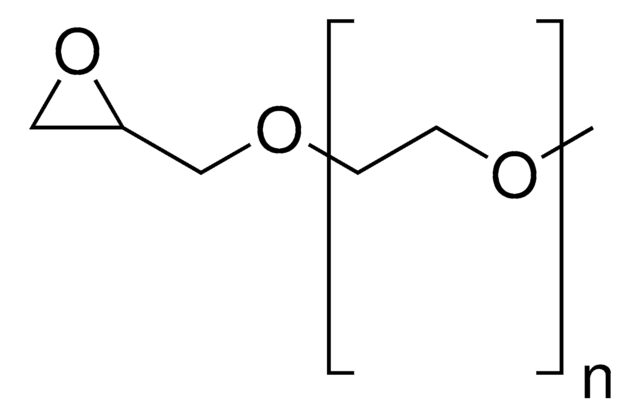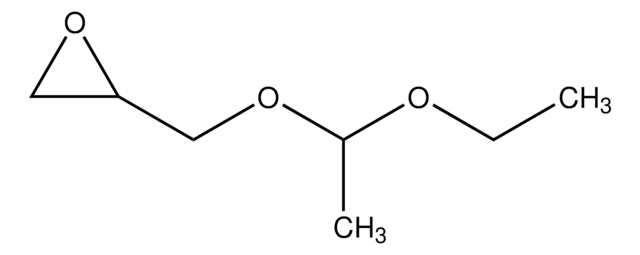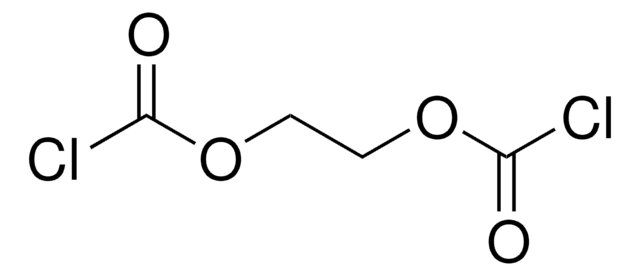731811
Poly(ethylene glycol) diglycidyl ether
average MN 2,000, cross-linking reagent amine reactive
Sinônimo(s):
Polyethylene glycol, Diepoxy PEG, PEG diglycidyl ether, Polyoxyethylene bis(glycidyl ether)
About This Item
Produtos recomendados
Nome do produto
Poly(ethylene glycol) diglycidyl ether, average Mn 2,000
Formulário
liquid
Nível de qualidade
peso molecular
average Mn 2,000
adequação da reação
reagent type: cross-linking reagent
reactivity: amine reactive
pf
49-54 °C
arquitetura do polímero
shape: linear
functionality: homobifunctional
temperatura de armazenamento
2-8°C
InChI
1S/C8H14O4/c1(9-3-7-5-11-7)2-10-4-8-6-12-8/h7-8H,1-6H2
chave InChI
AOBIOSPNXBMOAT-UHFFFAOYSA-N
Procurando produtos similares? Visita Guia de comparação de produtos
Aplicação
- Impact of Poly(ethylene glycol) Diglycidyl Ether on PVC/PEO Blend Properties: This study examines the influence of PEGDE on the tensile properties, morphology, and electrical conductivity of PVC/PEO blends, highlighting its effectiveness as a surface modifier (Supri et al., 2016).
- Flexible Wearable Sensors Based on CNTs and PEGDGE: This research focuses on developing flexible wearable sensors by reinforcing carbon nanotubes with PEGDGE, analyzing their strain sensitivity and mechanical properties (Del Bosque et al., 2021).
- Network Polymers via Addition Reactions of Multifunctional-Amine and PEGDGE: The synthesis of network polymers through the reaction of multifunctional-amine and PEGDGE or diacrylate compounds, exploring their application in materials science (Naga et al., 2020).
- Modification of Alkali Lignin with PEGDGE for Bio-lubricant Applications: This study modifies alkali lignin with PEGDGE to enhance its use as a thickener in bio-lubricant formulations, demonstrating improved dispersion and stability (Cortés-Triviño et al., 2018).
- Characterization of Injectable Hyaluronic Acid Dermal Fillers Cross-Linked with PEGDGE: Investigates hyaluronic acid dermal fillers cross-linked with PEGDGE, focusing on their physicochemical properties and applications in aesthetic medicine (Zerbinati et al., 2021).
Código de classe de armazenamento
12 - Non Combustible Liquids
Classe de risco de água (WGK)
WGK 3
Escolha uma das versões mais recentes:
Já possui este produto?
Encontre a documentação dos produtos que você adquiriu recentemente na biblioteca de documentos.
Os clientes também visualizaram
Artigos
Highlighting existing and novel fabrication methods for both, solid and hydrogel-based scaffold for tissue engineering applications.
Nossa equipe de cientistas tem experiência em todas as áreas de pesquisa, incluindo Life Sciences, ciência de materiais, síntese química, cromatografia, química analítica e muitas outras.
Entre em contato com a assistência técnica










